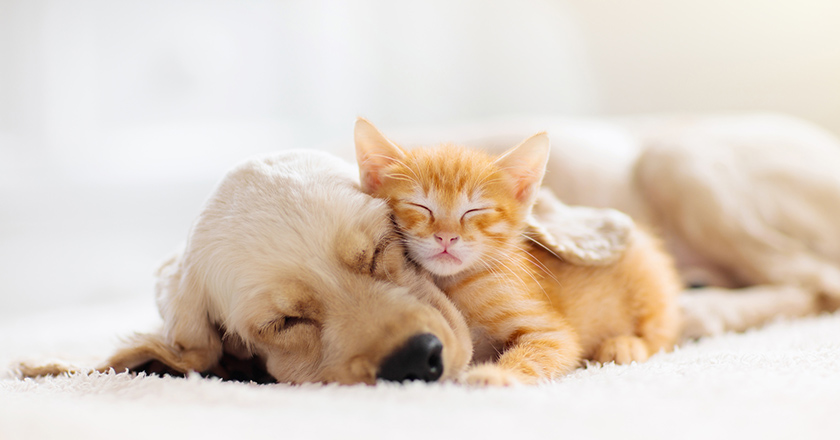The power of intestinal bacteria to make people and pets healthier
With the advancement of science and medicine, the healthy life span is increasing, and it is called the era of the 100-year lifespan. The increase in life span applies not only to humans but also to pet animals such as dogs and cats.
In this modern age, the family structure has changed drastically from half a century ago, especially in urban areas. Dogs and cats have become treated as companion animals to fill the vacancies in the family structure. It is considered that pet animals’ average life expectancy has been increased by being treated with care as family members.
However, as aging of pet animals progresses, various diseases also appear. Among them, skin diseases and diseases of the digestive system are at the top of the list for both dogs and cats, and prevention and treatment of such diseases are being sought. Of course, not only pet animals but also humans have skin problems, and people of all ages, from infants to the elderly, can have these problems.
Skin problems are caused by contact between the skin and allergenic factors in the environment, but food and stress also play a role in whether inflammation subsides or develops. Food and stress are also major causes of digestive problems in dogs and cats.
In the first place, most of the components in food are used as materials to make animals’ bodies and as fuel to move their bodies. Some of them have the effect of maintaining the body function and are called functional components.
However, many of these components are present in a form that is not readily usable and may not be able to display their physiological functions when taken as a normal diet.
This is where bacteria that have a symbiotic relationship with their hosts come in. Many bacteria live in the digestive tract, and some of them have abilities that animals do not have. In other words, there are chemical reactions that only bacteria can create.
By taking advantage of these special intestinal bacteria and slightly changing the molecular structure of the components in food to convert them into functional molecules, it is possible to enhance the barrier and immune functions of the skin.
In our laboratory, we are conducting research with the goal of developing foods that can help prevent and treat skin and digestive diseases in dogs and cats by utilizing the ability of these special intestinal bacteria.
Dogs and cats are close in diet to humans, and it is relatively easy to procure samples of excreta. By elucidating the digestion mechanism and the relationship between food and body condition, it is also expected to contribute to human health.
Conversion of discarded materials into active components
For skin diseases in dogs and cats, for example, I think that it is easier for animals to accept the prevention of skin diseases by oral application, such as daily diet, rather than taking a surgical approach, which is symptomatic therapy. It will also be more advantageous in cost.
In addition, while topical ointments and toners basically only affect the area where they are applied, if functional components are taken as food, they are delivered from the digestive organs to the skin, which is peripheral tissue, via the bloodstream. As a result, it may be possible to solve skin problems drastically, such as stimulating the metabolism of a wider range of cells and the synthesis of moisturizing proteins.
However, from a market perspective, the process of discovering functional components and turning them into food is inevitably costly. Another issue is whether products with added value will be widely accepted when introduced into the pet market.
If that’s the case, can’t we make good use of what they usually eat? This is to target substances that are usually excreted without being digested very well, or substances that do not provide nutritional benefits because they are not converted well in the body.
That means adding some new intestinal bacteria to daily diet to convert them into high-value substances. If we make effective use of discarded food instead of wasting it, it won’t change the daily diet significantly, so I think it will be easy for everyone to use and thus spread efficiently.
The intestinal bacteria that live in the digestive organs are diverse, and it is estimated that there are more than 100 trillion of them. Animals provide the residues of food to intestinal bacteria, which in turn produce a variety of compounds as metabolites. What the bacteria are doing is creating simple chemical reactions, in which a slight shift in the position of the bond changes the function that affects the body.
In our laboratory, we are developing candidates for these potentially useful bacteria, by their reaction with chemicals, and examining the products.
For example, ceramides in rice and bread have properties that lead to activation of skin cells, but they are not absorbed as they are. We discovered for the first time in the world an intestinal bacterium that chemically changes ceramide to make it easier for the body to break down and absorb.
It has also been shown that using the new intestinal bacteria to make better use of ceramide reduces the production of melanin, the source of blemishes, and reduces inflammation in animals with dermatitis and colitis.
At this stage, we have not reached the point of commercialization, but our goal is to enable dogs and cats to consume effective bacteria through freeze-dried or processed foods, for example. In the future, we would like to develop functional pet foods using intestinal bacteria through academic-industrial cooperation.
Using a variety of bacteria will also reduce waste in the process of making food. Actually, the parts that are discarded in the process of food production and processing may also contain functional components.
For example, most of a konjac potato is discarded after extracting mannan, a component used in jellies. Can’t we use bacteria to convert certain kinds of lipids and sugars contained in the discarded parts into active components and use them in medicine and food?
Food issues are global challenges, so adding values and developing new products while taking advantage of limited resources and materials will contribute to building a sustainable society.
Health benefits derived from greasy foods
The research on converting food components by intestinal bacteria is also approached from directions other than ceramide. One of these is the use of newly isolated intestinal bacteria to further enhance the function of omega-3 fatty acids and to convert omega-6 fatty acids, which act as competitors to omega-3 fatty acids, into functional components.
Omega-3 fatty acids, which are often talked about on TV these days, are unsaturated fatty acids that are abundant in blue-skinned fish such as mackerel and saury, and in plants such as perilla and flax, and are known for their ability to suppress fat uptake in the body.
Omega-3 fatty acids can function as they are, but if they are transformed into functional components through the activity of special bacteria, they can be expected to further elicit various health benefits, such as reducing inflammation.
Humans consume a lot of fats such as potato chips and noodles in their daily diet. In addition, owing to lifestyle and food distribution, there are many opportunities to consume processed foods, which contain a large amount of fat. Our laboratory is working on finding bacteria that can convert some of those fats into something useful, and we’ve already found some candidates.
A fundamental negative effect of oil components is to induce obesity. Enlarged fat cells release proteins called cytokines, which have various negative effects on the body.
Because the release of cytokines contributes to the symptoms of inflammation, it may be possible to reduce that inflammation by reducing cytokine production with special bacteria that enhance the immune function. In other words, there is a possibility that obesity can be suppressed by using special bacteria.
In the future, potato chips might be made with special bacteria that are less likely to make you obese.
In this way, animals and food are inseparable. While the world faces challenges such as a food crisis and food loss, people are also dieting for health and caring about beauty through food.
In this context, intestinal bacteria, which have a symbiotic relationship with humans and other animals, will become even more important in the future in terms of eliminating waste and contributing to good health.
Maintaining a healthy body through the daily diet also helps to reduce the frequency of antibiotic use, which may lead to the emergence of new drug-resistant bacteria. Preventing future pandemics caused by drug-resistant bacteria is an urgent issue for all humans, pets, and domestic animals.
Dogs and cats are like family to their owners, supporting human health in both mental and physical aspects. I think there will be a new step in our lives when research on intestinal bacteria advances and functional pet foods become popular.
Information noted in the articles and videos, such as positions and affiliations, are current at the time of production.


